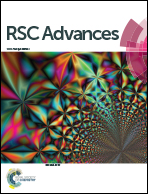Improved photo-luminescence behaviour of Eu3+ activated CaMoO4 nanoparticles via Zn2+ incorporation†
Abstract
Zn2+ (0, 2, 5, 7 and 10 at%) co-doped CaMoO4:2Eu3+ nanophosphors have been synthesized via the polyol method using ethylene glycol (EG) as both capping agent and reaction medium at 150 °C. From XRD analysis, all 900 °C annealed Zn co-doped CaMoO4:Eu3+ nanophosphors have a tetragonal scheelite phase. Some extra phase evolution has been observed for the as-prepared Zn doped samples. The intensity and crystallinity of XRD patterns increase as heat treatment increases to 900 °C. The valence states of the involved compositions (Zn co-doped CaMoO4:Eu) were investigated by X-ray photoelectron spectroscopy (XPS) and it was found that Ca, Mo, Eu and Zn are in their +2, +6, +3 and +2 oxidation states, respectively. TG-DSC studies of the as-prepared samples corroborate their thermal stability. A TEM (Transmission electron microscopy) study reveals that the particles have spherical morphology. Photoluminescence studies have been carried out under ∼266, and 395 nm excitation wavelengths. Zn co-doping in the CaMoO4:Eu matrix produces a high distortion and modifies the crystal field around the Eu3+ ion and improves the PL intensity. CIE co-ordinates of the 900 °C annealed 10 at% Zn co-doped CaMoO4:Eu sample under 266 nm excitation is x = 0.64 and y = 0.35, which are close to the standard of NTSC (x = 0.67 and y = 0.33). These investigations reveal that Zn co-doped CaMoO4:Eu3+ nano-materials can be used as potential red emitting phosphors, an area which is a bottleneck in the development of low cost LEDs.


 Please wait while we load your content...
Please wait while we load your content...